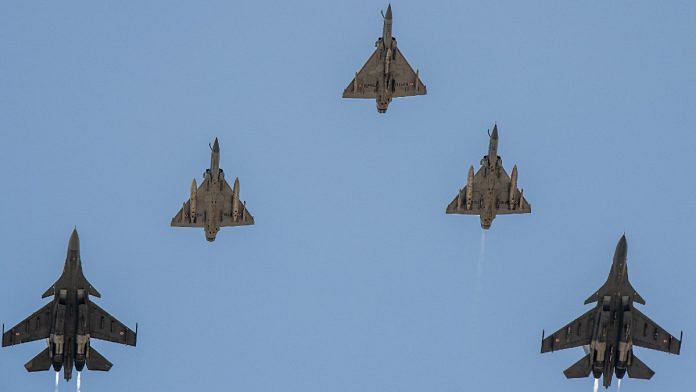The US-made F-16s are now adding a new sound to the roaring thunder regularly heard from Jodhpur Air Force Station. It is, after all, the aircraft much tracked over the decades by the Indian Air Force. And the hunted is out hunting with the hunters over the deserts of Rajasthan as India and Oman conduct their biennial air exercises, Eastern Bridge VI. The air exercise is the latest in a series of valuable military exchanges the two countries have been conducting, involving the three armed forces. Military diplomacy adding to close political and economic relations.
Royal Air Force Oman flies two squadrons of F-16 C/D Block 50, and it is of course the same aircraft that has been in the crosshairs of Indian Air Force combat jets over the last few decades. Because the Pakistan Air Force has been flying the F-16s since 1981 when Islamabad became the darling of Washington for helping raise the mujahideen opposition to the Soviet occupation of Afghanistan. Since then, it has emerged as the primary PAF combat aircraft, and much in the line of IAF targeting. In fact, the PAF F-16s were known to have ‘lit up’ IAF Mirage 2000s on their combat runs against Pakistan Army positions during the Kargil conflict. ‘Lit up’ is Air Force speak for locking in on an aircraft without actually engaging it with a missile that has got its radar to highlight the aircraft as a target. The IAF Mirage 2000s and Mig-29s were known to have reciprocated with similar intimidation gestures.
The IAF has deployed a multitude of aircraft for Eastern Bridge VI, from Jaguars, Mirage 2000s to the Su-30s. The bilateral exercise will conclude on 25 February and is aimed at enhancing interoperability between the two Services of what are mutually regarded as friendly countries. Such joint military exercises are valuable for raising confidence between the armed forces involved and their political authorities.
India and Oman have been conducting bilateral military exercises involving the three armed forces since the 1993 Naseem Al Bahr joint naval manoeuvres. While the two armies conduct Al Nagah joint exercises, including at the dramatic Jabal Akhdar mountain in the Ad Dakhiliyah Governorate of Oman.
Also read: Finance ministry’s ‘assured funds’ is old story. Army can utilise land to generate revenue
Old ties new challenges
RAFO operates its F-16s from Thumrait Air Base in the once restive frankincense-growing Dhofar Governorate, adjoining Yemen to the west. For more than a decade, Oman fought communist guerrillas supported by then South Yemen in an insurgency that involved tribes and trans-border operations aplenty. Oman was fully supported by the secretive British Special Air Service and finally put an end to the uprising in 1976. Since then, the SAS has regularly used Oman as its desert and summer training location. Thumrait Air Base has also hosted the United States Air Force 1st Special Operations Wing, further underlining the value of Oman as a stable regional partner in the global campaign against terror.
India has, of course, known Oman for millennia, joined by a common culture of trading and interaction over centuries. Dhofar is also famous for its monsoon season, and it is on the seasonal winds that trade was carried between the Arabian Peninsula and India, moving east as well as westwards. So it is necessary for regional security that military interaction between the two countries extend beyond simply biennial exercises. While India has been given access to Duqm Port in Oman, it shouldn’t simply be a case of making courtesy calls. “One of the cheapest items is an Indian AK-47, at $140 (Dh515) each, but fighters disparage its poor quality compared to the heat-resistant North Korean version at $600,” said a 2009 article.
This is of course an allegation more than a decade old, but Indian dhows (sailing vessels) are extensively involved in trading other items lucrative to smugglers. They connect the Arabian Peninsula region with Gujarat and ports along the Somalia coast. Where once they relied on the monsoon winds to power their sails, diesel motors chug along the waves, evading capture and enhancing profits. The trade is risky but hugely profitable, hence the risks involved. Which then also raises worries about the kinds of goods being traded. Narcotics are almost conjoined with terrorists.
So it is vital that India and Oman enhance their cooperation by participating in joint interception operations in the high seas. For that jointness to happen, both will have to move on from simply combat aircraft, big naval ships, or even rappelling on mountain sides. India must place Special Forces on the ground to operate with Omani forces and maintain pressure on the smuggling routes. Which is far more important for Indian national security than deploying warships and Marine Commandos to snatch a runaway Dubai princess from the high seas.
Manvendra Singh is a Congress leader and Editor-in-Chief of Defence & Security Alert. He tweets @ManvendraJasol. Views are personal.
(Edited by Anurag Chaubey)






